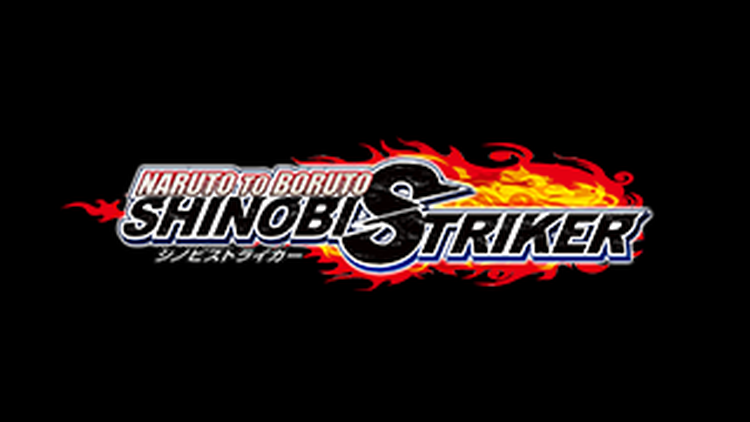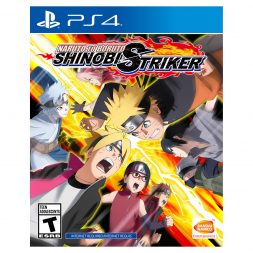
Naruto is back with another video game adventure. This time however the gameplay is different than previous entries in the long-running franchise. Check out the 4 v. 4 online action of Naruto to Boruto: Shinobi Striker.
 Naruto to Boruto: Shinobi Striker Details
Naruto to Boruto: Shinobi Striker Details
Platform: PlayStation 4, Xbox One
Developer: Soleil
Publisher: Bandai Namco
Genre: Online brawler
Modes: Single-player, multiplayer
ESRB Rating: T (Teen)
Intense online battles
In Naruto to Boruto: Shinobi Striker you will participate in 4 v. 4 combat in online multiplayer gameplay. As ninjas the crux of the game centers around hand to hand combat. However matches are not simply straight up fights, but rather team based competitions with various objectives to complete.
For example, in a “Barrier” match, the attacking team must attack and defeat a boss monster. The opposing team will in turn work to defend it. Furthermore the boss is protected by barrier with multiple control points that must first be contended by the attacking team.
These game types create a necessary level of strategy and teamwork to the competition. It is not simply enough to have the strongest individuals or the best fighters. Working together is key to success, and those that play well together will strongly benefit.
Naruto to Boruto: Shinobi Stiker also offers a VR arena where offline and co-op missions take place. This offers a bit of much needed variety, but nothing substantial. The only truly meaty part of the game is it’s online play.

A well balanced team
Another key to victory in Naruto to Boruto: Shinobi Strikers is striking the right balance of personnel. Four ninjas comprise a team, and naturally there are also 4 unique roles to choose from. Players can opt for an attack, defense, ranged, or healer class.
This complement of classes should look familiar to most gamers familiar with MMO’s or similar style of games. Attackers focus on damaging the opponent, while defenders (ie “tanks”) draw and absorb the biggest amount of damage. The range class can scout and attack from a distance, while the heal class focuses on support.
Thankfully you have a loadout slot for each class of ninja. Players can switch between classes easily without having to juggle equipment or skills. You’ll even be able to switch your loadout mid-match between spawns if you are knocked out.

Middling combat
Naturally, victory comes more often when a team works together, especially with a balance of roles. In my matchmaking experience I found that player level did not correspond with success, but teamwork certainly did. If my cohort was a healthy mix of roles, we were likely to perform better than if everyone simply fell back on the attack role—somewhat regardless of level.
The combat it self is a bit hit-or-miss for me. The action is generally a balance of delivering timely super-powers and button-mashing melee combat in-between. Timing and skill are important to a degree, but overall I don’t really see the appeal in trying to master it. The actual hand-to-hand fighting is more of a wash in relation to overall team strategy.

Upgrading your ninja
As you progress through the game you’ll be able to improve your fighter by upgrading equipment and skills. You can also earn aesthetic rewards to make your custom avatar even more unique. Players can purchase or earn upgrades in a variety of ways, but all stem from in-game participation.
Some weapons and equipment can be purchased from a vendor. Currency to spend on these wares is one of the rewards you will receive in combat. You can also sell unwanted to get some currency back.
There are also rewards tied to completing certain missions, as well as mentor rewards unlocked as you train under specific NPC’s. When the game first prompted me to choose a mentor, I found it a bit disappointing when I learned that each one wouldn’t necessarily send me on a specific path or guide my skills. Rather mentors just offer a different branch of rewards.
Granted, a healer mentor for example will likely offer rewards that will improve the healer class specifically, but they don’t necessarily unlock because you are a good healer. Ultimately the mentor mechanic wears a bit of a disguise of depth, when really it’s a pretty shallow one that just offers a bit of variety in how you earn loot.

Mystery scrolls
Probably the most exciting way to earn rewards is through scrolls. You will earn a variety of them as you play, with better rewards tied to more rare scroll types.
Of course you’ll have to take your scrolls to the shop to be decoded. They are basically Naruto to Boruto: Shinobi Striker‘s version of engrams in the popular Destiny games. It works well though, as the excitement of decoding a rare scroll adds to the joy of earning new loot.

What’s all the “hub” bub?
Naruto to Boruto: Shinobi Striker tries to lean even further into the Destiny model by placing players in a central hub world when not in combat. Unfortunately the game is a bit to bare for this to make sense, and it suffers a bit for it.
The hub has 5 main destinations, but 3 of these could easily be rolled into one, or frankly rolled into the pause menu instead. For example, players can only equip new gear at the inn. That means running over and entering it every time you want to tweak a loadout. This is something I really want to be able to do anytime from a menu, but it’s delegated to the inn as an attempt to flesh out the skeletal hub world.
Gorgeous art
Naruto to Boruto: Shinobi Striker does shine from an artistic standpoint, at least for my tastes. The bright colours and cel-shaded graphics are reminiscent of the Gravity Rush series—one of my favourite PlayStation exclusives. I have not had the pleasure of enjoying Naruto in manga or anime form, so I can’t really speak to what a bigger fan might want to see, but for my video game sensibilities it’s a solid win visually.

Naruto to Boruto: Shinobi Striker is a light online team brawler
Based on some of the comparisons I’ve drawn, it’s probably clear that I see Naruto to Boruto: Shinobi Striker as trying to mimic some of today’s more popular social online combat experiences. It certainly has the loot-hunting aspect down, and it’s lovely cel-shaded art style offers even more to appreciate.
That said, the hub world is a watered down version of some of these larger big-budget titles. The combat is serviceable, but it lacks a truly satisfying loop that these types of games really need to keep players coming back to grind for more. Nevertheless if you do enjoy it, and/or if you have a good group of friends to work with, the 4 v. 4 matches do offer some interesting and strategic gameplay.
+ Strategic 4 v. 4 battles
+ Beautiful cel-shaded art style
+ Plenty of loot to unlock
– Middling combat
– Bare, unnecessary hub world
– Mentors that don’t really mentor
OVERALL ASSESSMENT OF NARUTO TO BORUTO: SHINOBI STRIKERS
Gameplay: 3.5/5
Graphics: 4/5
Sound: 3.5/5
Lasting Appeal/Replayability: 3.5/5
Overall Rating 3.6/5 (73%)
Get Naruto to Boruto: Shinobi Striker for PlayStation 4
Get Naruto to Boruto: Shinobi Striker for Xbox One
Purchase Naruto to Boruto: Shinobi Striker (Digital Download) for PlayStation 4
Purchase Naruto to Boruto: Shinobi Striker (Digital Download) for Xbox One
Get Naruto to Boruto: Shinobi Striker Deluxe Edition (Digital Download) for PlayStation 4
Get Naruto to Boruto: Shinobi Striker Deluxe Edition (Digital Download) for Xbox One
Purchase Naruto to Boruto: Shinobi Striker Season Pass (Digital Download) for PlayStation 4
Purchase Naruto to Boruto: Shinobi Striker Season Pass (Digital Download) for Xbox One
Click here to see the full line of video game software available at Bestbuy.ca
Click here to see digital video game downloads offered at BestBuy.ca



